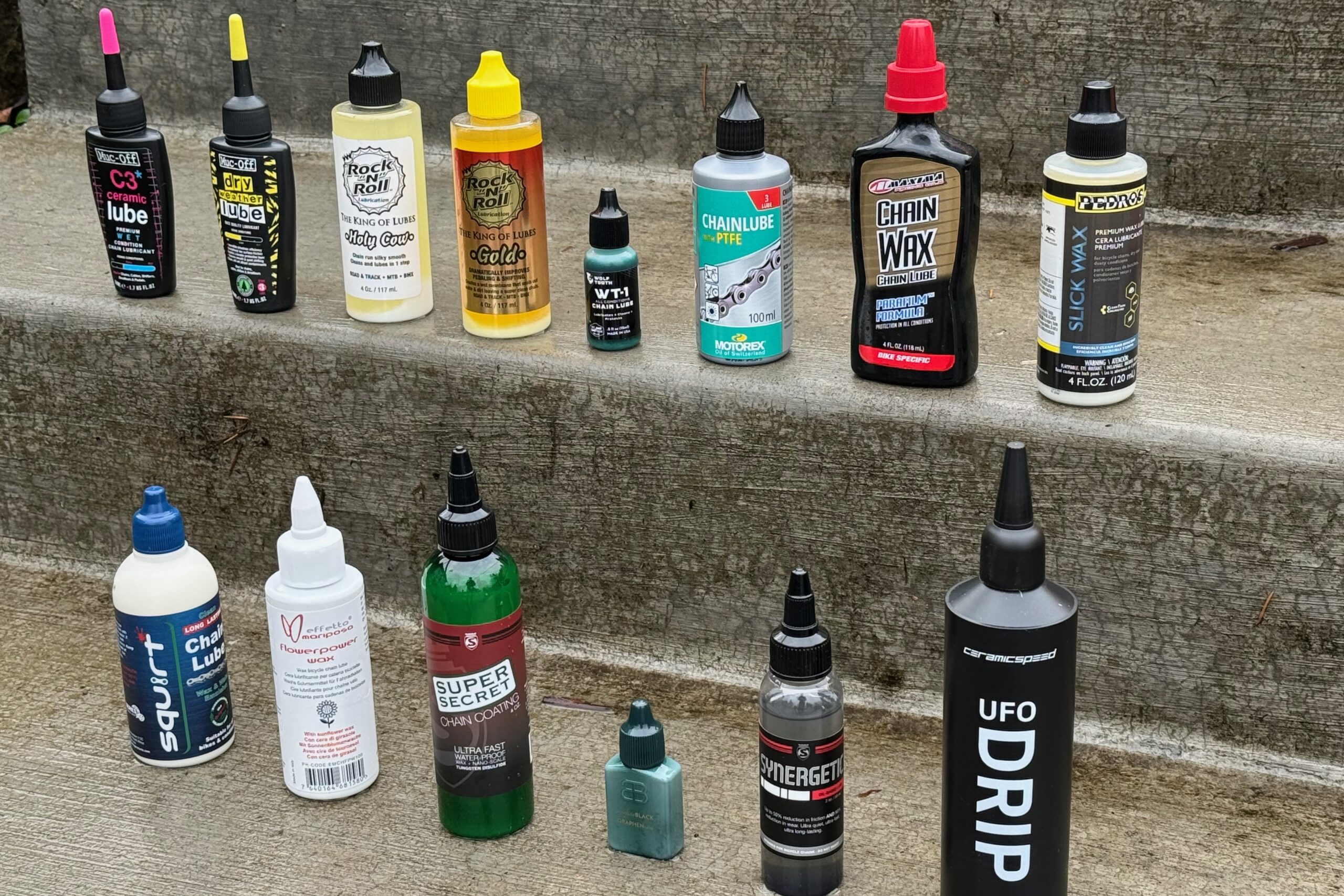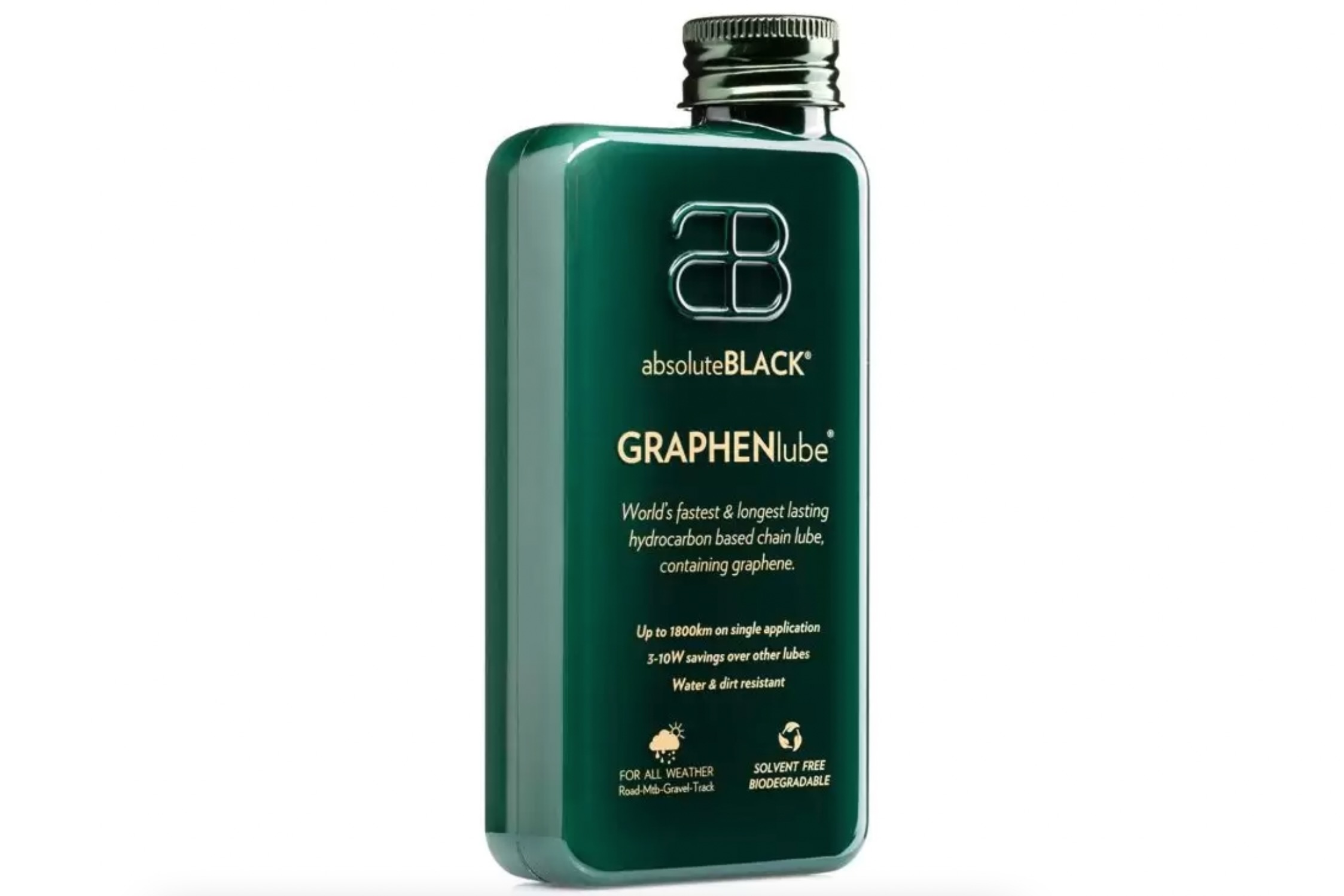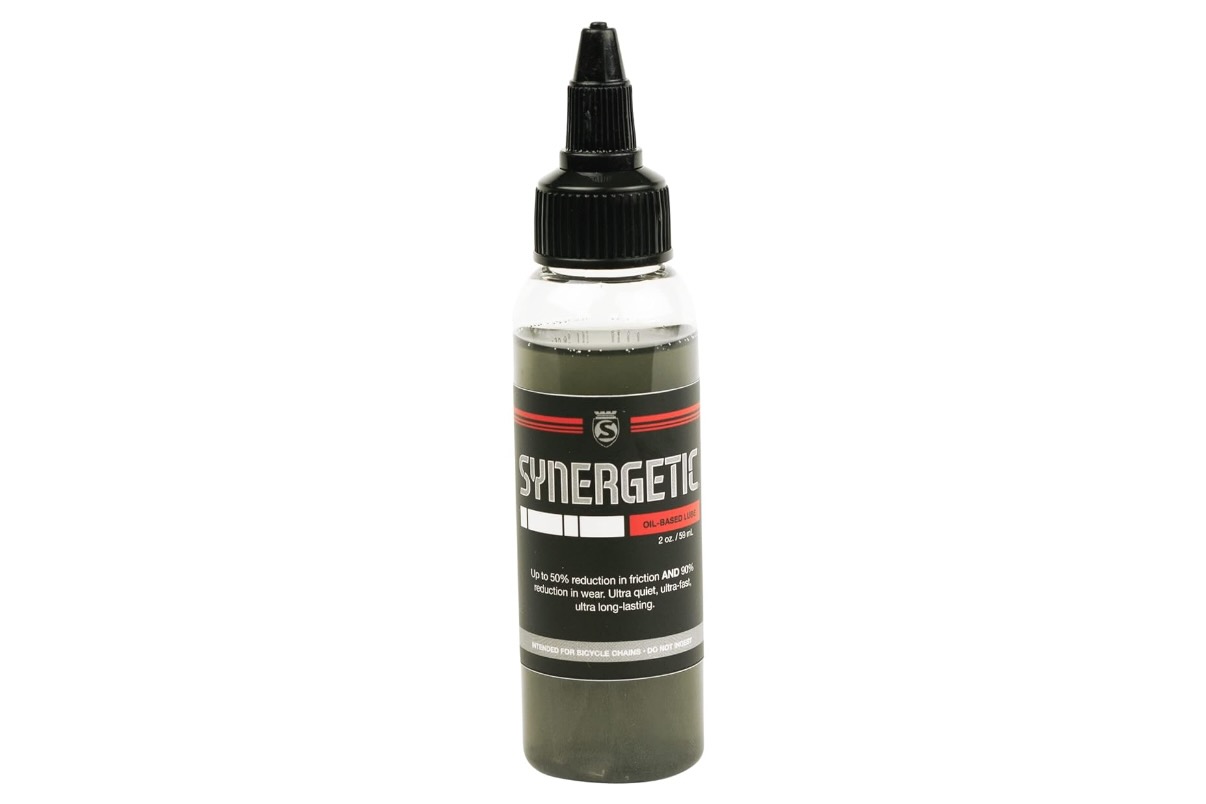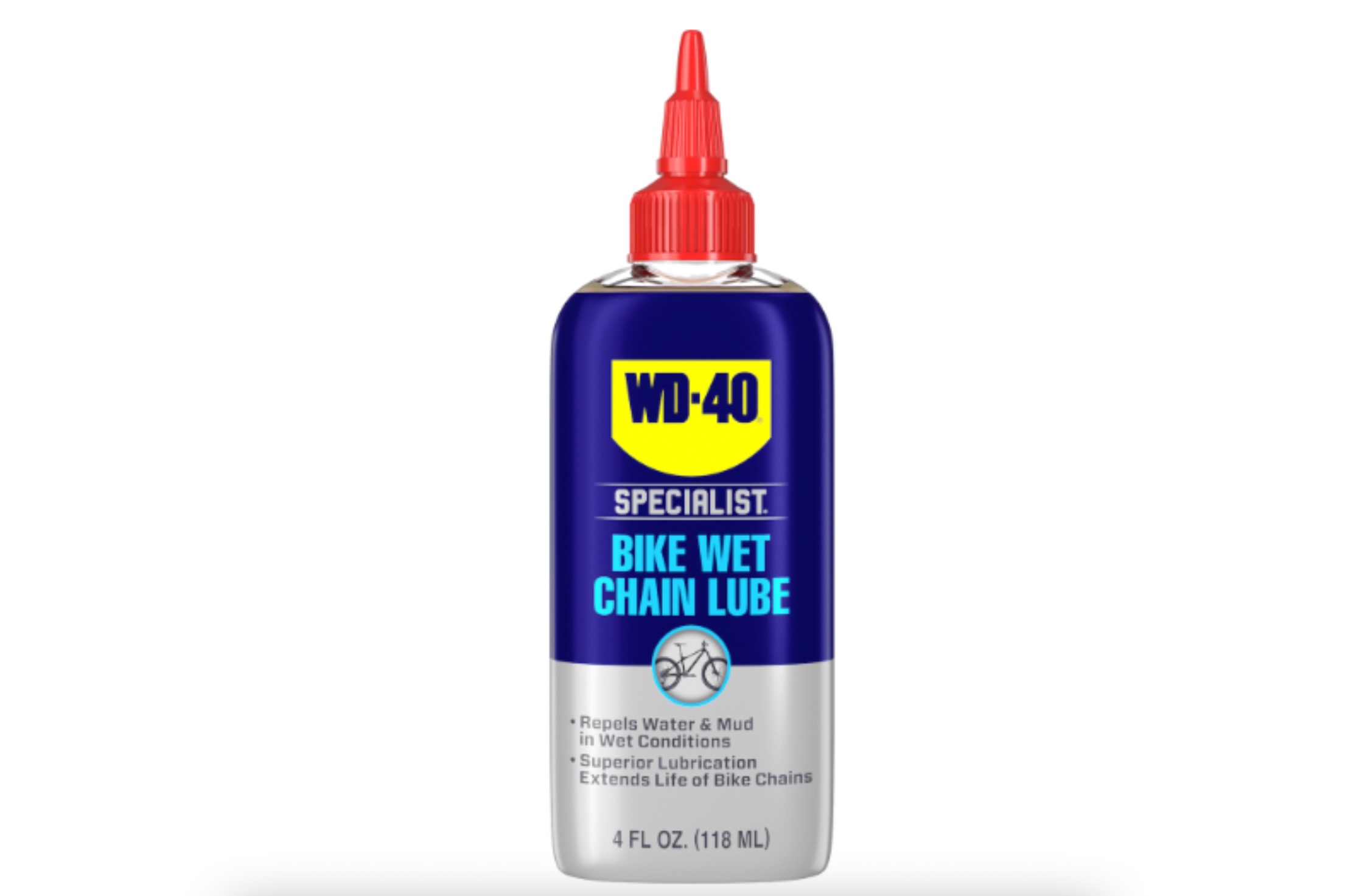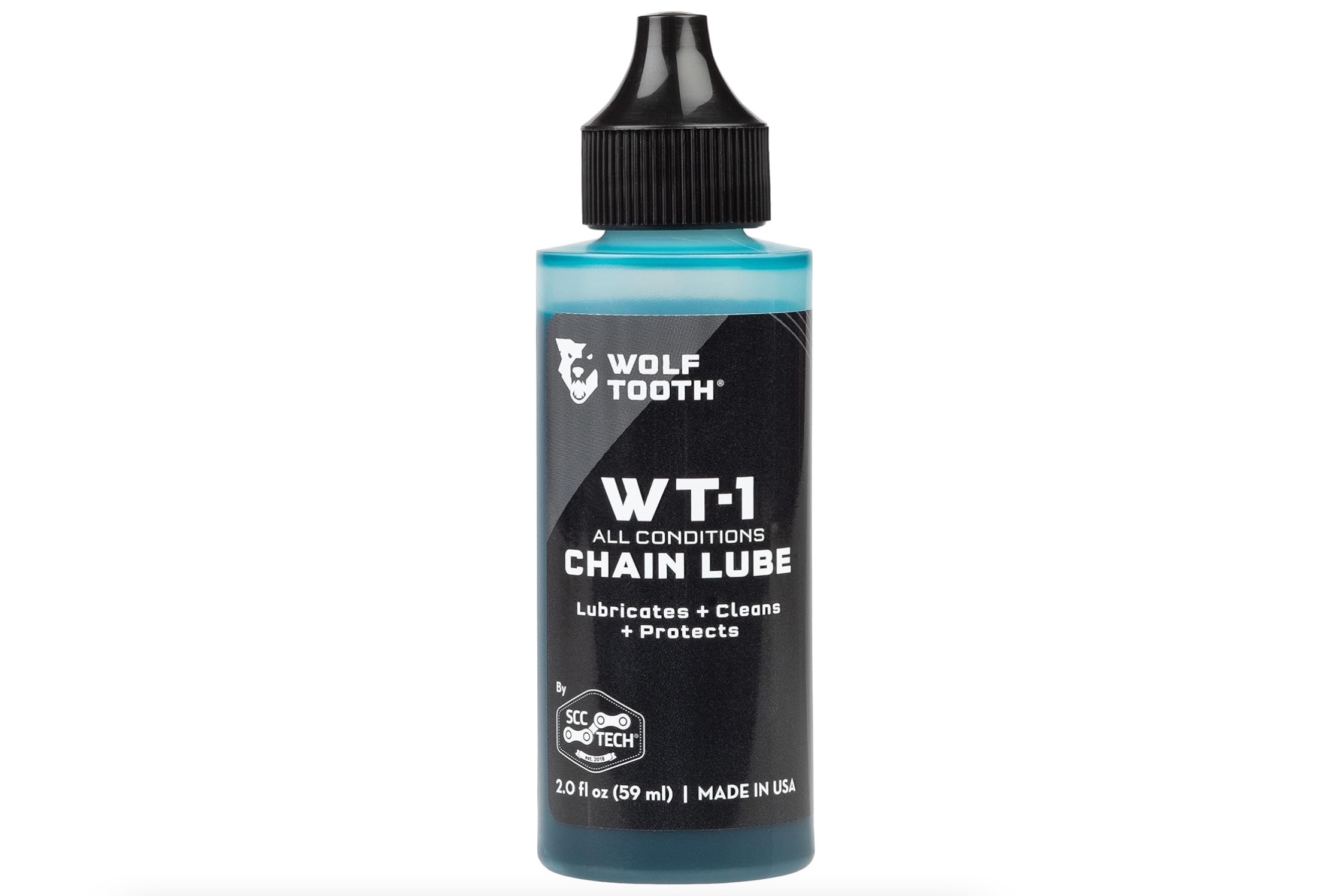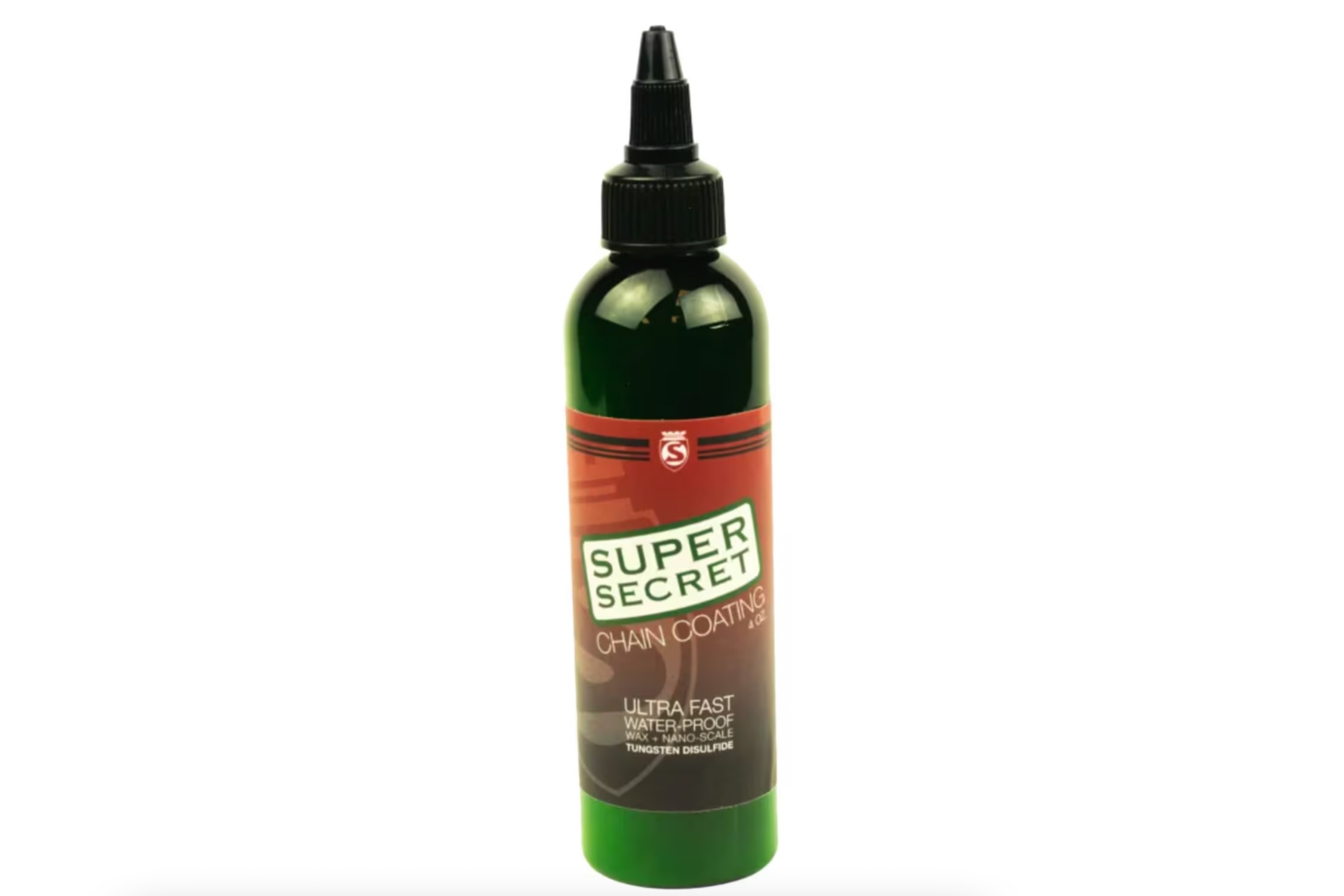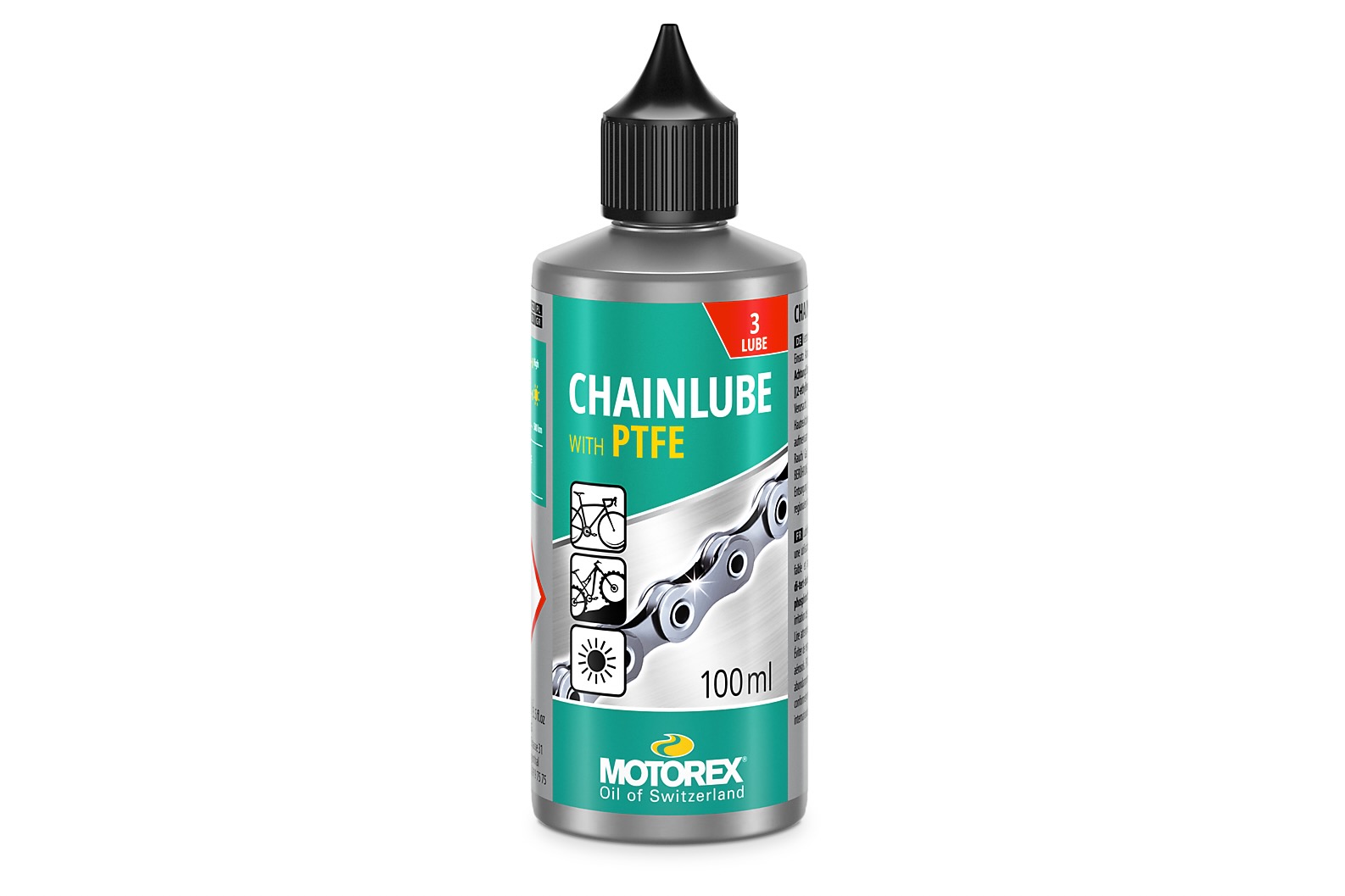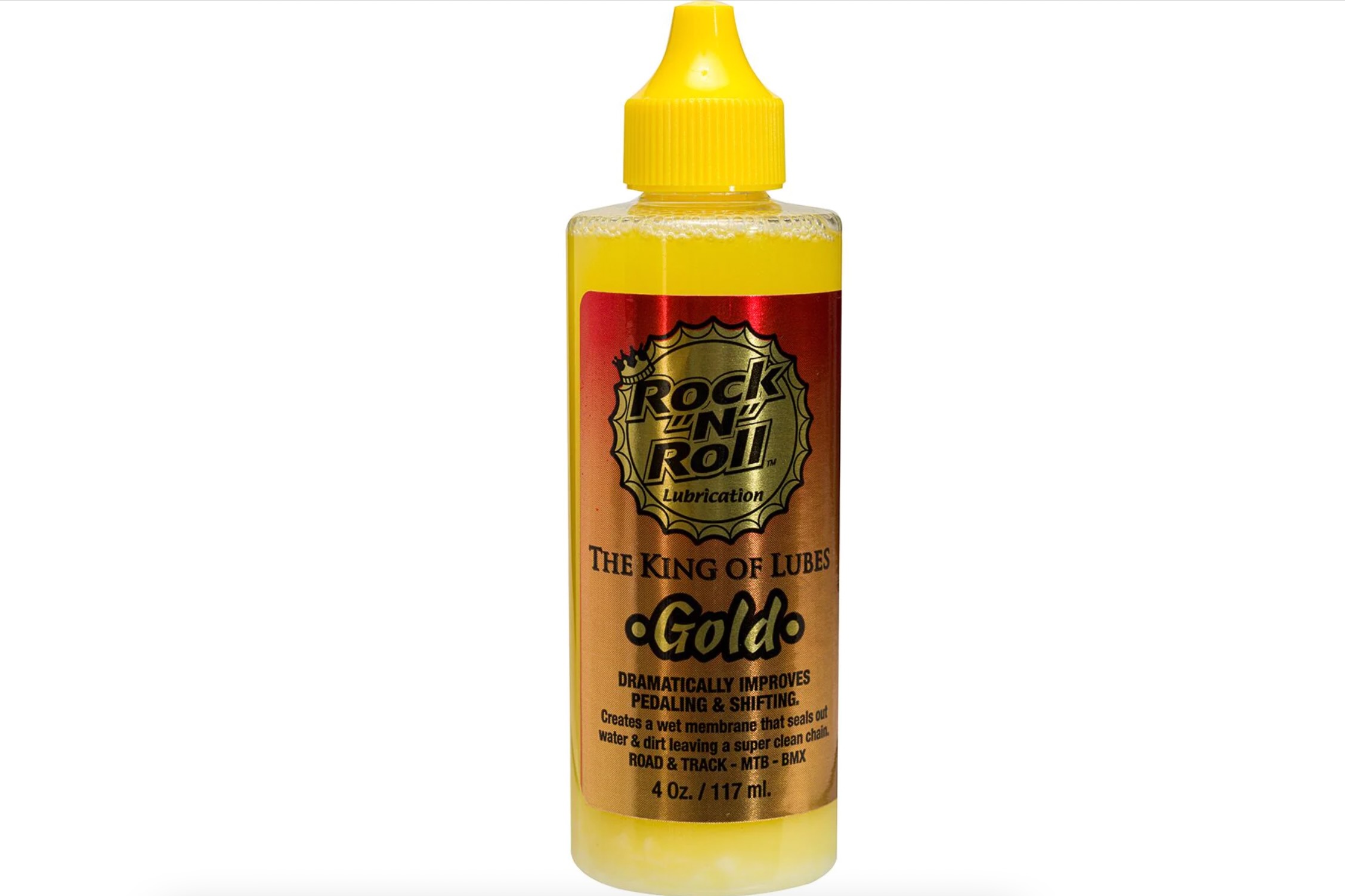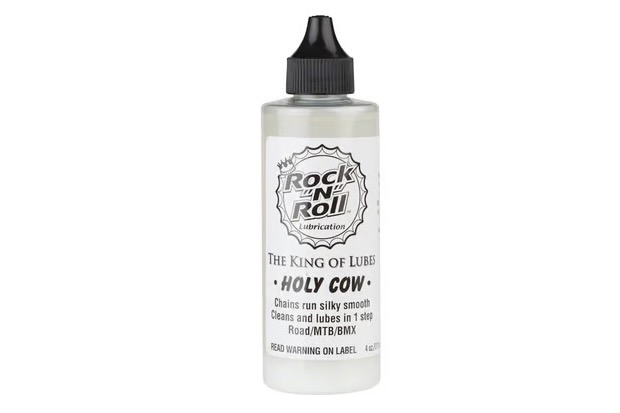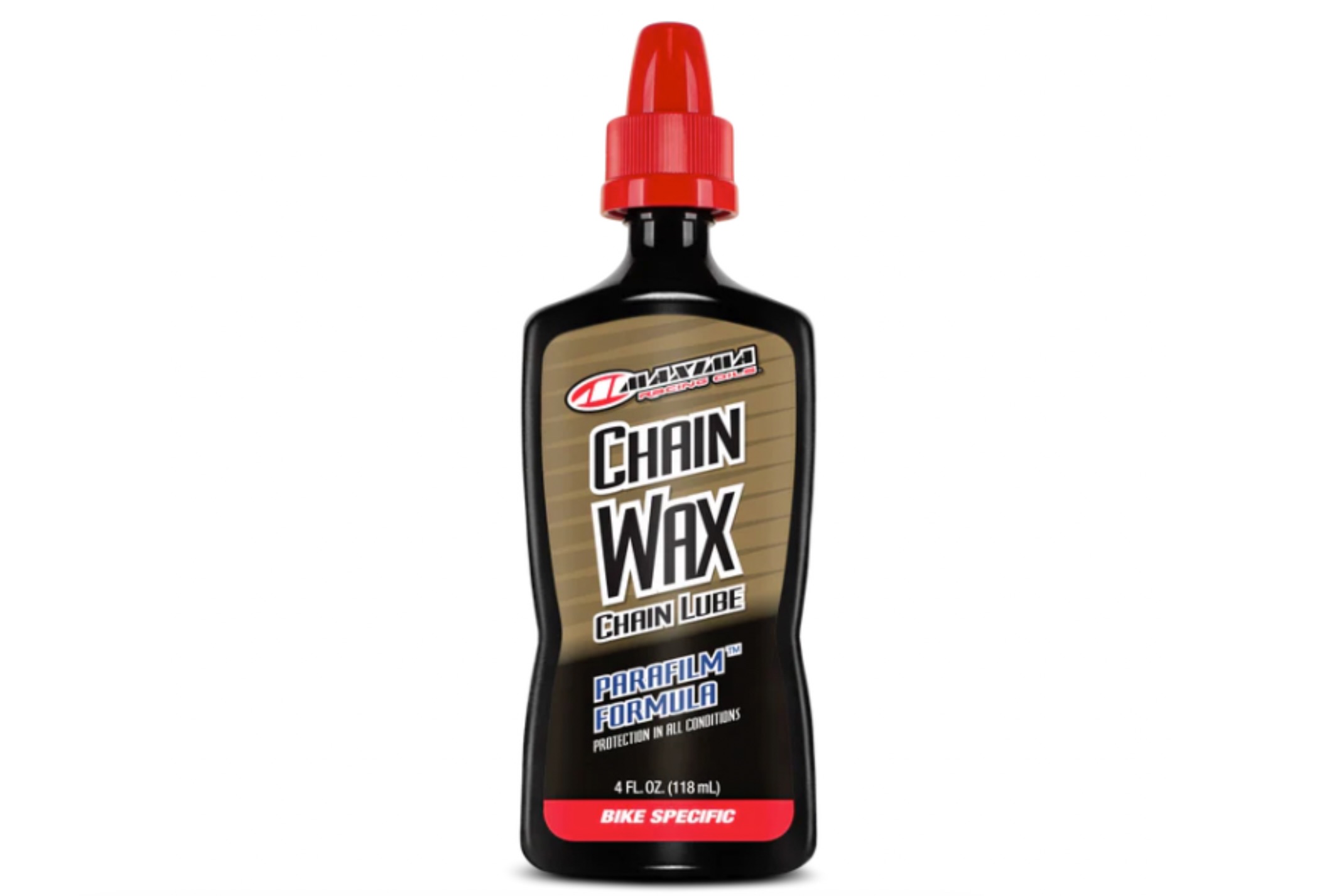A quality chain lubricant is vital for the performance and lifespan of the entire drivetrain. As the chain runs across your cassette, chainrings, and rear derailleur pulleys, any contamination or lack of lubrication will gradually wear down the precisely machined teeth of these components, leading to noise, a reduction of efficiency, sloppy shifting, and eventually, a hefty replacement cost.
Think of the chain as the heart of your bike’s drivetrain. If it’s gunked up with contaminants, it’s not able to function efficiently, and performance suffers. Not only will you waste power overcoming more friction in your chain, but that friction will accelerate wear on all of your drivetrain components, which can combine to cost many hundreds of dollars to replace. By making a small investment in a quality chain lube, big gains in not only performance but bank account balances can be achieved.
There are a dizzying number of chain lubes on the market, with wet lubes, dry lubes, and wax-based drip-on coatings all claiming to be the best. All these options can make it hard to figure out which is the best lube for your bike, riding style, and the conditions you encounter out on the road or trail. Additionally, there are very strong and widely varying opinions on what lubes are the best. Based on our experience, popularity, and independent test lab results, we gathered 14 of the best chain lubes on the market to test and compare.
Our top chain lube recommendations are listed below, followed by the best of the rest which we feel are all worthy of consideration as well. To see all the chain lubes we tested at a glance, check out our comparison chart. If you’re unsure of what you need, our buying advice includes helpful information to guide your purchase decision, and we’ve got answers to common questions in our FAQ section.
The Best Bike Chain Lubes of 2024
- Best Overall Drip Wax Chain Lube: Effetto Mariposa Flowerpower Wax
- Best Value Drip Wax Chain Lube: Squirt Long Lasting Chain Lube
- Runner-Up Best Drip Wax Chain Lube: Ceramic Speed UFO Drip All Conditions
- Best Money-No-Object Chain Lube: absoluteBLACK Graphenlube
- Best Overall Wet Chain Lube: Silca Synergetic Wet Lube
- Best Value Wet Chain Lube: WD-40 Specialist Bike Wet Lube
- Easiest Chain Lube to Use: Wolf Tooth WT-1 Chain Lube
- MSRP: $21.00 (100ml), $68.00 (500ml)
- Volume: 100ml (4.06 oz), 500ml (16.9 oz)
- Price Per Ounce: $5.17 (100ml size)
- Type: Wax
- Composition: Sunflower Seed Wax, NO hazardous additives
- Recommended use: All conditions
Pros
- Highly efficient
- Over 50% wax content
- Long-lasting
- Biodegradable
Cons
- Requires perfectly clean chain
- MSRP: $15
- Volume: 4 oz (120ml), also comes in 15ml and 500ml
- Price Per Ounce: $3.75
- Type: Wax
- Composition: 100% biodegradable waxes with water
- Recommended use: All Conditions
Pros
- Runs quiet
- Inexpensive
- Extends drivetrain service life
Cons
- Can separate if it freezes
- MSRP: $24.00
- Volume: 100ml (3.38 oz)
- Price Per Ounce: $7.10
- Type: Wax
- Composition: Non-toxic and biodegradable wax-based formula
- Recommended Use: All Conditions
Pros
- Runs quiet
- Hangs tough in wet conditions
- Long-lasting
Cons
- Expensive
- Extensive chain prep required
- MSRP: $19.95 (0.47 oz) to $145.95 (4.7 oz)
- Volume: 0.47 oz (14ml) / 4.7 oz (140ml)
- Price Per Ounce: $42.45 (0.47 oz size)
- Type: Wax
- Composition: Hydrocarbon (wax) based water emulsion containing a special mix of high purity Graphene.
- Recommended use: All conditions
Pros
- Runs super quiet
- Saves watts
- Protects drivetrain
- Lasts a long time
Cons
- VERY expensive
- MSRP: $25 (2oz)
- Volume: 2 oz
- Price Per Ounce: $12.50
- Type: Oil
- Composition: ZDDP Oil with nano-particles of Tungsten Di-Sulfide
- Recommended use: All conditions
Pros
- Tribofilm protects from wear
- Easy to apply
- Precise applicator reduces waste
Cons
- Quite expensive
- Prone to settling – needs vigorous shaking
- MSRP: $10
- Volume: 4 oz
- Price Per Ounce: $2.50
- Type: Oil
- Composition: Proprietary oil-based formula
- Recommended Use: Wet Weather
Pros
- Reasonable price
- Works well in wet, muddy conditions
- Easy to apply
Cons
- Not great for dry conditions
- Needs frequent cleaning and reapplications – like most wet lubes
- MSRP: $18.95 (2oz) $6.95 (0.5 oz)
- Volume: 2 oz, also comes in 0.5 oz
- Price Per Ounce: $9.48
- Type: Oil
- Composition: Solvent refined light naphthenic oil
- Recommended use: All conditions
Pros
- Pushes out contaminants as you ride
- Affordable
- Zero chain prep is required
Cons
- Fairly expensive
Best of the Rest
- MSRP: $12.50
- Volume: 4 oz (120ml)
- Price Per Ounce: $3.13
- Type: Wax
- Composition: Wax, plant-based and biodegradable chemistry, No Parrafins or PTFE
- Recommended use: Dry weather
Pros
- Affordable
- Runs quiet
- Stays clean
- Biodegradable
Cons
- Needs extensive chain cleaning for 1st application
- Needs time to cure
- MSRP: $45 (8oz) $25 (4 oz) $16 (2 oz)
- Volume: 8, 4, or 2 oz.
- Price Per Ounce: 8oz: $5.63, 4oz: $6.25, 2oz: $8
- Type: Wax
- Composition: Tungsten Disulphide, biodegradable waxes, with alcohol
- Recommended use: All conditions
Pros
- Quickly penetrates
- Runs quiet
- Extends drivetrain service life
Cons
- Expensive
- Requires a new chain to be stripped clean
- MSRP: $12.85 (100ml)
- Volume: 100ml (3.38 oz)
- Price Per Ounce: $3.80
- Type: Oil
- Composition: Oil-based, fully synthetic with PTFE
- Recommended use: Dry weather
Pros
- Affordable
- Repels dirt and dust
- Hangs tough on wet rides
Cons
- PTFE is non-biodegradable
- Requires frequent reapplication
- MSRP: $8
- Volume: 4 oz, also comes in 16 oz
- Price Per Ounce: $2.00
- Type: Oil
- Composition: Oil-based
- Recommended use: All Conditions
Pros
- Affordable
- Repels dirt and dust
- Hangs tough on wet rides
Cons
- Needs time to cure
- MSRP: $8.00
- Volume: 4 oz
- Price Per Ounce: $2.00
- Type: Wet lube
- Composition: No information available
- Recommended use: All conditions
Pros
- Stays fairly clean
- Affordable
- Cleans and lubes in one
Cons
- Requires more frequent application than some
- MSRP: $11
- Volume: 4 oz
- Price Per Ounce: $2.75
- Type: Wax
- Composition: Proprietary Parafilm Formula
- Recommended use: All conditions
Pros
- Runs quiet
- Inexpensive
- Easy-to-use applicator
Cons
- Strong scent
- MSRP: $12.00
- Volume: 120ml (4.06 oz), also comes in 50ml
- Price Per Ounce: $3.00
- Type: Wax
- Composition: Wax-based
- Recommended use: Dry weather
Pros
- Affordable
- Precise application
- Stays clean
Cons
- Needs frequent reapplication
- MSRP: $17.00 (120ml)
- Volume: 120ml (4.06 oz), also comes in 50ml (1.7 oz)
- Price Per Ounce: $4.19
- Type: Oil
- Composition: Oil-based with fluoro polymers and boron nitrides
- Recommended use: Wet weather
Pros
- Reatively affordable
- Precise application
- Hangs tough in horrid conditions
Cons
- Needs frequent reapplication
- Gets dirty – chain needs to be wiped down regularly
Comparison Chart
| Chain Lube | MSRP | Volume | Price per Ounce | Type | Recommended Use |
|---|---|---|---|---|---|
| Effetto Mariposa Flowerpower Wax | $21 | 100ml (3.38 oz) | $5.17 | Wax | All Conditions |
| Squirt Long Lasting Chain Lube | $15 | 4 oz | $3.75 | Wax | All Conditions |
| Ceramic Speed UFO Drip All Conditions | $24 | 100ml (3.38 oz) | $7.10 | Wax | All Conditions |
| absoluteBLACK Graphenlube | $19.95 | 0.47 oz | $42.45 (0.47 oz. size) | Wax | All Conditions |
| Silca Synergetic Wet Lube | $25 | 2 oz | $12.50 | Oil-based | All Conditions |
| WD-40 Specialist Bike Wet Lube | $10 | 4 oz | $2.50 | Oil-based | Wet Weather |
| Wolf Tooth WT-1 Chain Lube | $18.95 | 2 oz | $9.48 | Oil-based | All Conditions |
| Pedro’s Slick Wax | $12.50 | 4 oz | $3.13 | Wax | Dry weather |
| Silca Super Secret Chain Lube | $45 – $16 | 8, 4, or 2 oz | $5.63 to $8 (varies by size) | Wax | All Conditions |
| Motorex Chainlube with PTFE | $12.85 | 100ml (3.38 oz) | $3.80 | Oil-based | Dry Weather |
| Rock N’ Roll Gold | $8 | 4 oz | $2.00 | Oil-based | All Conditions |
| Rock N’ Roll Holy Cow | $8 | 4 oz | $2.00 | Wet | All conditions |
| Maxima Chain Wax Parafilm | $11 | 4 oz | $2.75 | Wax | All Conditions |
| Muc-Off Dry Weather Lube | $12 | 4.06 oz | $3.00 | Wax-based | Dry Weather |
| Muc-Off C3 Ceramic Wet Weather Lube | $17 | 4.06 oz | $4.19 | Oil-based | Wet Weather |
Why You Should Trust Us
At Bikerumor, we ride all kinds of bikes, a lot, and we know there are few things more annoying than a squeaky chain or wearing out expensive drivetrain components prematurely. Of course, taking good care of and maintaining our drivetrains helps, but we’ve also learned that choosing the right chain lube can do wonders to keep things running smoothly, and quietly, and reduce the friction that causes our chains, chainrings, cassettes, and derailleur pulleys to ultimately wear out. We’re also in the business of reporting on and testing new products and technologies, and we strive to provide our readers with trustworthy and honest opinions of the products we review.
For our chain lube buyer’s guide, we tasked Bennett Shane with testing the vast majority of the 14 different products in this review and added a couple that are highly regarded by other members of our team. Bennett is an avid road cyclist who spends an inordinate amount of time riding for fun, fitness, and product testing purposes. He lives outside of Portland, Oregon where he encounters the full spectrum of riding conditions throughout the year. He has a small fleet of high-end road bikes and prefers it when they run quietly, smoothly, and efficiently while protecting his expensive drivetrain componentry from premature wear. Bennett has been testing a huge range of product categories over the past year, including road bike tires, cycling bib tights, winter cycling gloves, road bike helmets, and more. His years of riding experience combined with his testing experience have given him an excellent ability to tease out the often subtle differences between the products he tests, which is of particular importance for something like chain lube.
It’s important to note that we did not perform scientific friction or wear testing on the lubricants in this buyer’s guide. Since this type of analysis is quite difficult to perform and requires highly specialized equipment, we’ll leave that to the experts who already do that type of lab testing. Zero Friction Cycling (ZFC) is one such resource that does independent laboratory testing of chain lubricants and publishes in-depth findings online. Much like Virgina tech’s independent helmet impact testing, we use ZFC’s findings to inform ourselves and help choose the products we tested. Our testing focuses more on using these products in the real world while examining factors like ease of application, drivetrain noise, contamination, cleanliness, and longevity when used in various weather conditions. To do that we gathered a diverse selection of 14 of the best chain lubes on the market to test and compare. Bennett Shane personally tested the vast majority of the chain lubes included here, and we added a few options that are favorites of our bike-obsessed editors, with the goal of highlighting the best options for every budget and riding condition.

Buying Advice: How To Choose Bike Chain Lube
With so many options on the market, it can be hard to decide which chain lube is right for you. We’ll cover some of the factors to consider in this buying advice article with more information provided in our FAQ section below.
Types of Bike Chain Lube
Although there are a dizzying number of chain lubes available, all claiming to be the best available, they can be broadly divided into three categories, wet, dry, and wax-based, one of which will likely suit your needs best for most of the season, if not all throughout it. Generally speaking, wet lubes are best for wet conditions, dry lubes are aimed at dry conditions, and most of the drip-on wax lubes we tested claim to be effective in all conditions unless otherwise stated.

Wet
Synthetic or oil-based “wet” lube, goes on thick and wet, and remains highly viscous, helping the chain run quiet and shift smoothly between gears. A benefit of many wet lubricants is that they repel water and stick tenaciously to the chain, making them a great choice for riding in wet conditions. The potential downside to this type of lube is that its oil-based composition remains wet and sticky which can attract contamination from dust and dirt that lingers in the air or gets sprayed up from wet roads. So, cleaning the chain and reapplying wet lube generally needs to be done more frequently to maintain its effectiveness. Examples include WD-40 Specialist Bike Wet Lube, Muc-Off C3 Ceramic Wet Weather Lube, and Silca Synergetic Wet Lube.

Dry
Next up are light and midweight “dry” lubes. While the term “dry lube” may sound strange, rest assured that these will not dry out your chain and cause it to squeak and slow you down. These lubrications are dry in the sense that they don’t attract and absorb contaminants the way wet lubes do. So, for arid, dry, and dusty conditions, they can keep your chain running more smoothly and save the components in your drivetrain from wearing out prematurely. Dry lubes are typically more susceptible to washing off in wet conditions, however, leaving your chain dangerously exposed to premature wear. We tested three lubes that are specifically intended for use in dry conditions including Pedro’s Slick Wax, Muc-Off Dry Weather Lube, and Motorex Chainlube with PTFE.

Wax
Wax-based chain lubes are actually more of a protective coating. These coatings cover the chain in liquid wax and then cure to the metal to create a barrier against friction and contamination. Traditionally, these wax chain coatings required full immersion of a perfectly clean and ideally brand-new chain in a crock pot full of searing hot wax. The process takes time and effort to complete and comes with a high initial cost, meaning that immersive wax is a growing but still niche style of chain maintenance that isn’t for everyone. Still, there are quite a few hot melt wax options like Molten Speed Wax, Silca Secret Chain Blend Hot Melt Wax, absoluteBlack’s GraphenWax, and others that are widely considered to be the gold standard.

The good news regarding wax-based lubricants is that they are now available in drip-on versions. The compositions of these drip lubes are similar to their immersive counterparts, so they promise a very high percentage of the same benefits in efficiency and protection against premature wear. They drip on just like wet and dry lube but still require the chain to be super clean in order to work effectively. Traditionally, they haven’t been the quietest lubes available, but some of the latest options are among the best in terms of drivetrain noise. Some of the drip-on wax-based lubes we tested at Effetto Mariposa Flowerpower, Ceramic Speed UFO Drip, Squirt Long Lasting, Maxima Chain Wax, and absoluteBLACK GraphenLube.
Pre-waxed Chains

Some brands and retailers offer brand-new chains that have been deep-cleaned and pre-waxed so that you don’t have to go through the hassle of doing it yourself. This is a good option for those who need to replace their chain and want to switch over to wax, but who might not have the tools, solvents, or time to do the whole deep-cleaning process for themselves. With a little searching, you can usually find popular high-end chains that come prepped from Kogel, Silca, Ceramic Speed, or absoluteBLACK, among others.
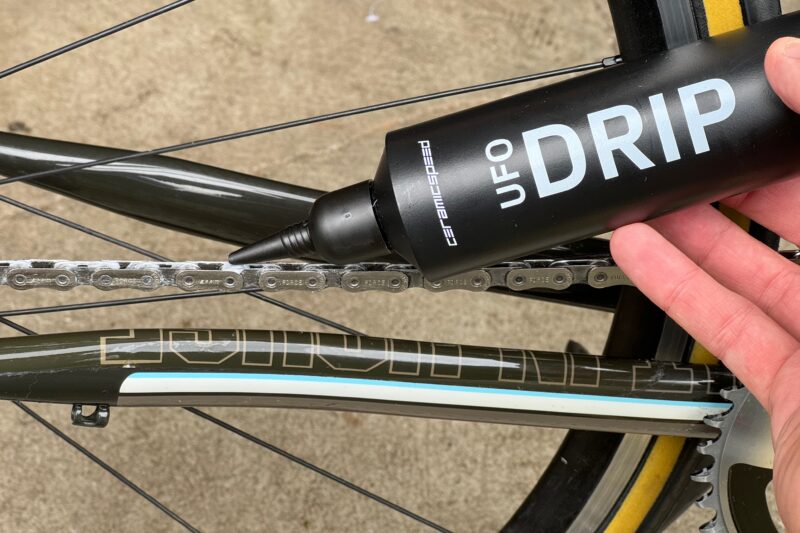
Application
With all chain lubes, it’s best to follow the manufacturer’s recommendations for application. This varies by the type of lube and often from brand to brand, but applying lube to a clean chain is almost always the best way to achieve optimal results. Many drip-on wax lubes specify that the chain must be perfectly clean before applying, so extensive cleaning must be done before the initial application. Even brand-new chains must be stripped of the factory coating so that the lube can effectively penetrate and lubricate the surfaces inside the rollers. Depending on the conditions you ride in and the amount of grime that gets stuck to the chain, subsequent applications may be as simple as wiping down the chain and reapplying, or as involved as a deep clean before reapplication.
Another important fact to remember is that the rollers of the chain are the critical points to lubricate. The outer plates are simply linking the rollers together, and do not need to be lubricated in order for the chain to be efficient. Excess lubrication on the surface of the chain will usually result in faster build-up of contamination and less efficient performance.

Cleaning
Whichever chain lube you choose to apply, it’s vital to also regularly clean the surface of the chain and occasionally deep clean it using a solvent or degreaser. This will remove contaminants that form an abrasive mess inside the chain internals over time. To clean the surface, it’s best to use a microfiber or course cotton cloth that pulls away surface junk before it infiltrates the chain. To remove that internal gunk, remove the chain and submerge it in a degreaser, or better yet in an ultrasonic cleaner. For a relatively deep clean without removing the chain, handheld chain scrubbers are a quick, easy, and effective option.
The best time to clean a nasty chain is as quickly as possible after you finish your ride. Don’t wait until 15 minutes before your next ride, by which time the gunk and debris have solidified and are much more challenging to remove. Additionally, any reapplication of lubricant needs time to penetrate the chain rollers in order to be effective, so at a minimum, it needs to be done a few hours ahead of time in the case of oil-based wet lube, or 12 hours for wax-based lube.
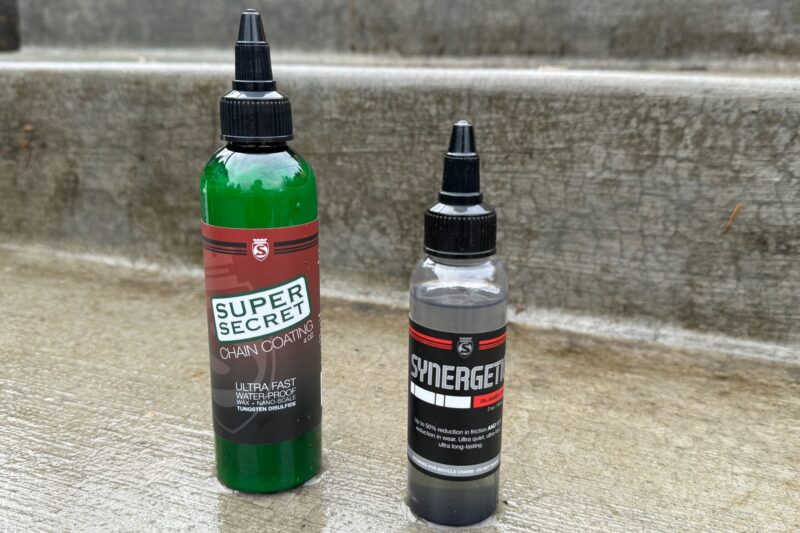
Value
Keeping your drivetrain clean and lubricated can help improve your efficiency and reduce friction that can lead to premature wear of your (often expensive) drivetrain components. As such, the upfront cost of a quality lube can save you money in the long term by extending the life of your chain, chainrings, and cassette. Still, chain lubes vary quite dramatically in price from around $2 an ounce up to over $40 an ounce. It is absolutely fair to wonder what makes some lubes so much more expensive than others and if the added cost is worth it.
While there is most definitely some science backing up the friction reduction and watt savings of some high-end lubes, we’re still talking about marginal gains that are of most interest to super high-performance riders and racers. Most people will be just as well served by a lube that costs less and performs nearly as well. That said, many of the higher-end lubes also happen to be the longest lasting, meaning that some of the higher cost is offset by less frequent applications.

Frequently Asked Questions
Think about all of the work that your bicycle chain does. It’s what makes your bike move forward, and every revolution of your pedals forces each chain link to click over hundreds of teeth on your chainring and cassette. You’re basically grinding metal on metal.
If the chain is dry, rusty, or coated with a layer of grime, it reluctantly creaks and grinds through each pedal stroke while the friction and contaminants slowly grind at the contact surfaces and cause all of the components, the chain, cassette, and chainring, to wear out.
Chain lube not only protects against corrosion, but it reduces friction to help keep that chain moving freely which can enhance efficiency and reduce the wear on your drivetrain. It helps to keep your drivetrain running smoothly and quietly and can extend the service life of all your drivetrain components.
Unfortunately, the answer here is “it depends.” There are various factors at play including the conditions you ride in and the lube you use. If your chain is looking or feeling gritty, or you’re starting to hear it squeak, that’s a good indicator that it’s time to clean and re-lube your chain. This may come after a single muddy, wet ride, or it could come after several hundred miles of dry riding. Paying close attention to how your drivetrain looks, feels, and sounds will be the best way to determine when it’s time to reapply.
Most chain lubes won’t work well if you’re applying them incorrectly. Thankfully, it’s a pretty simple task, though it can be messy if you’re not careful. (Stay off white carpets while applying it.) There is some variability between types of lubes and brands, but most manufacturers provide recommendations to achieve the best results.
Start by cleaning and degreasing your chain (keep reading for tips on how to do that).
For oil-based lubes most experts recommend dripping a single drop of lube on each roller in the chain. Use the quick link as your starting and finishing point so you don’t do it twice! Let it sit for 30 seconds, then backpedal for 15-20 revolutions to allow the lube to sink in and penetrate the nooks and crannies of the chain. Once you’ve done that, take a clean rag and wipe down any excess lube before heading out the door. Don’t skip this step or you’ll instantly start to collect grime.
For drip-on wax-based lubes, it is recommended to apply it to a perfectly clean and dry chain (for the initial application) and to give the lube time to “cure” for up to 12 hours. This takes a little more forethought than just squirting some lube on the chain minutes before you head out for a ride, but typically it’s easy enough to apply the lube the night before and let it sit overnight so that it has adequate time to penetrate the chain’s internals and form a hardened protective layer.
Often, people will skip the degreasing step and just lube the chain, counting on the lube and subsequent wipe-down to remove most of the built-up gunk. While this will quiet a chain, this is definitely not the best way to approach cleaning and lubing your drivetrain and may actually accelerate wear with more lube trapping more grit and contaminants. It does, however, depend on the type of lube you’re using, as a few brands claim that their products clean and lube the chain in one.
Even with those all-in-one lubes, like those from Rock N’ Roll or the Wolf Tooth WT-1, we feel it’s always best to start with a super clean chain and go from there. They are intended to push contaminants out as you ride, so you’ll want to be sure to wipe those away frequently to remove them from the system.
Since wax-based lubes don’t attract as much grit and tend to flake off a bit as you ride, you may only need to wipe down your chain unless you can feel grit trapped in there. In general, wax-based lubes don’t require as frequent of cleaning.
Most oil-based lubes aren’t designed to clean your chain (with the exception of the Wolf Tooth WT-1 Synthetic mentioned above). In fact, it can just end up creating a sludge that acts like liquid sandpaper and wears down your entire drivetrain faster, costing you more in the long run. Not to mention getting all over your socks, legs, walls, car…everything.
The more common oil-based lubricants are classic because they’re easy to use, and in most cases, they keep a chain running quietly and smoothly. But unless you’re regularly cleaning and degreasing your chain, oil lubricants are dirt magnets, attracting dust and grit as you pedal.
On the other hand, some cyclists might have experience using actual wax, which provides the same smooth and quiet riding experience without as much grime. Originally, waxing a chain required a labor-intensive wax melting process (and the use of a slow-cooker or saucepan). While it was cumbersome, the results couldn’t be matched by oil-based lubricants.
Thankfully, new technology has allowed for the development of wax lubricants in liquid, drip-on form, making them as easy to apply as their oil-based counterparts but with the longevity and friction-reducing benefits of wax. So, with drip-on wax-based lubes like Effetto Mariposa Flowerpower, Ceramic Speed UFO Drip, Silca Super Secret, and Squirt, you can get the best of both worlds.
If you’re riding inside on the trainer, you may want to stick to an oil-based lube. Wax sloughs off as it’s used, so you may end up with a carpet stained by “greasy” chunks of wax if you’re not careful.
And if your riding conditions are wet and sloppy, wet, oil-based lubes, especially those specifically designed for wet conditions, have traditionally been better to overcome the constant onslaught of rain, mud, slush, and grime. That said, in those conditions, you’ll want to be sure to clean your drivetrain and reapply lube more frequently.
It’s only in recent years that lube companies have shifted to looking for eco-friendly options. According to The Ecologist, many lubricants were made with environmentally unfriendly Teflon and petroleum distillates. More recently, many chain lube brands are striving to provide more environmentally friendly products that still perform just as well.
Think about how you wash your bike, near a storm drain or on the grass in your backyard, or how your chain lube may get into the soil if you’re out on a long ride. It seems like a minor thing, but finding a chain lube that is biodegradable is just a small way to help reduce your carbon footprint (or tire tread in this instance).
In addition to the environment, chain lubes that don’t include toxic chemicals are also better for our health. Getting a lube on your hands that’s made from sunflower seeds like Effetto Mariposa Flowerpower, for example, is much less concerning than one that contains PTFEs or other forever chemicals.
Actual WD40 might seem like a substitute for chain lube since you use it to silence squeaky hinges or loosen tight bolts. But using WD40 as a lube on your chain is doing more harm than good: It acts as a degreaser, not a lubricant.
Use WD40 to clean your chain if you don’t have any Simple Green or your chain is so dirty that grease-fighting dish soap isn’t doing the trick, but we don’t recommend using it as a lubricant. (That said, the WD40 brand does make a chain lube that we recommend above.)
Yes. Your choice of chain lube should be more condition-dependent rather than bike-dependent. If you’re heading out on a wet or muddy ride, opt for wet chain lube. (Those tend to be popular with cyclocrossers.)
Ride in the desert? You’ll want a dry or wax-based chain lube to avoid a buildup of grit. If you bounce between settings or weather conditions, look for an all-around chain lube, though be prepared for frequent cleaning and reapplication, especially after particularly dusty or wet rides.
If you’re making the switch to a wax-based lubricant, the same rules as above apply: Clean and degrease your chain first. But it’s even more important when making this switch since the oil lube and wax lube won’t mix well together, so you want your chain to be completely oil and contaminant-free before making the transition. (Even if you’re starting with a new chain, clean and degrease it, since new chains come coated in heavy grease.)
Depends. Like most things in life, as you reach the upper echelons of performance, the price increases exponentially faster than the benefits. The gains in watts savings and friction reduction are real, but they are marginal enough that it probably doesn’t really for the vast majority of riders.
So, while the performance gains are subtle, there are other benefits: Longevity and silence.
The Silca, absoluteBLACK, and CeramicSpeed lubes are among the quietest we’ve used. When we’re cruising along and can’t hear or feel our drivetrain, we trick ourselves into feeling like it’s faster. So there’s that subliminal benefit, too.
They’re also some of the cleanest and longest-lasting. And some have ingredients that better protect the drivetrain, extending its lifespan.
Bottom line: Yes, they’re better, but maybe only worth the price if you’ve already optimized everything else.
The best and most thorough way to clean your chain is to remove it, soak it in degreaser or mineral spirits for an hour (or overnight), then spray it down with fresh degreaser and scrub all sides of it with a toothbrush. Then maybe some soap and water, rinse it and allow it to completely dry (like in a low-temp oven or direct sunlight).
Yes, this takes time, but if you’re prepping for a big event, complete overhaul, or switching to one of the premium chain lubes mentioned here, it’s worth the effort.
Alternatively, chain cleaners like the Park Tool Chain Gang kit often get it “clean enough” without having to remove it. The kit comes with a cassette cleaning tool and degreaser, too.
If you’re really time-crunched, the Finish Line Speed Bicycle Chain Degreaser works so well it’s scary. It literally blasts grease and dirt off your chain, leaving nothing but bare metal. The downsides are it’s not biodegradable (but is at least ozone-friendly), and that all that grease and grime ends up getting blasted onto whatever’s behind the chain…which can be your bike, garage floor, etc…make sure it doesn’t spray onto your disc brakes!
Here’s where it gets funny…most chain manufacturers will say no, that the stock grease is perfectly fine. Most chain lube brands will tell you that grease is too thick and a magnet for dust and dirt that also prevents lube from penetrating properly. We’d agree on the latter (third-party testing backs that up, too) and recommend using the cleaning method above to completely clean your chain first if you want to get the best possible performance from a lube.
Appropriate chain cleaning and lube reapplications will help elongate your chain’s lifespan. After every ride, give your chain and other drivetrain components a quick wipe-down to dry them off and remove buildup, especially if they got wet during your ride. This is even more important if you use a wet lube and ride in wet conditions frequently as mud, grit, and grime will get all over your chain. Consider the conditions you ride in, inspect your chain frequently, and clean and re-lube accordingly.
Many riders over-lube their chains. Generally, if there’s anything more than a light coating of chain lube on the outside of the chain, you’re just wasting lubricant, and risking it getting into other parts of the bike including the brake surfaces or rotors. Excess lube also ends up on the teeth of your cassette, chainrings, and derailleur pulleys. It becomes difficult to properly clean your drivetrain, collects dirt, and accelerates wear on your cassette and chainrings.
Avoid this by wiping excess lube from the chain after applying, ensuring that it’s nearly or entirely dry to the touch. Remember, generally speaking, you only need to apply lube to the rollers on the chain. Again, following the manufacturer’s recommendations is always a good idea.
